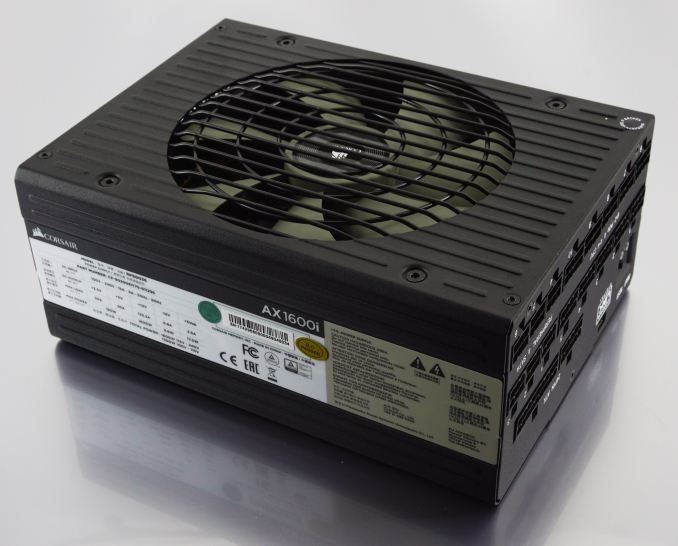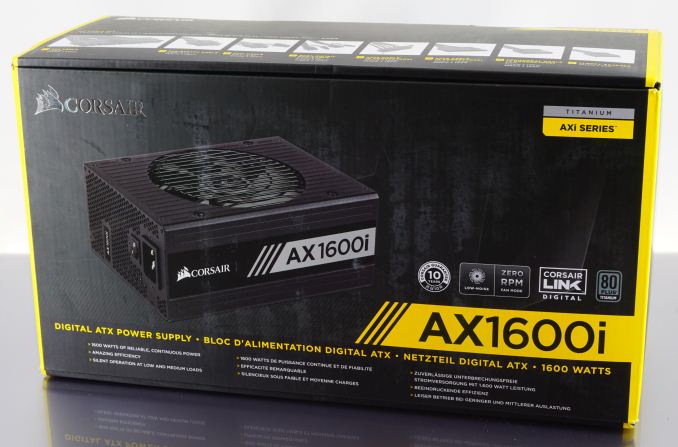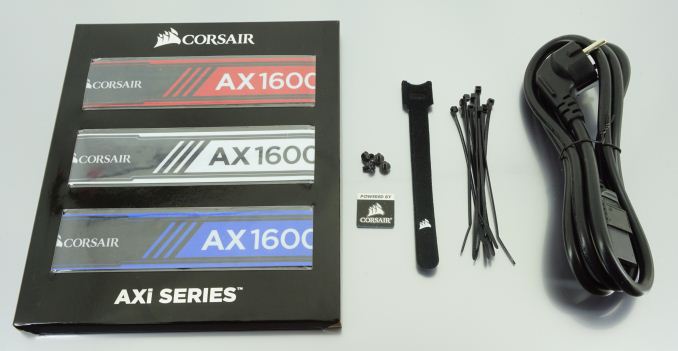The Emperor of Efficiency: Corsair's AX1600i PSU Rules Alone (Review)
by E. Fylladitakis on April 18, 2018 9:30 AM EST
Corsair is a company that needs no introduction. They are one of the oldest names in the PC industry and, although they initially only marketed memory-related products, nowadays the company has diversified into most segments of the PC market, with products ranging from PC hardware components to office/gaming chairs.
The company has been particularly active in the PC power supply (PSU) market. It was one of the first markets the company diversified into, and their first few products that the company released over a decade ago were a huge success. Nowadays Corsair is one of the biggest players in the PC PSU market, with dozens of competitive products covering every want and need.
The company places a lot of weight on their PSU division, which has been one of the innovation leaders during the past decade, always coming up with new features and/or technological upgrades. It is no chance that Corsair's units were always amongst the first to meet the new 80Plus programme certifications when they were being introduced. Corsair has always been trying to be a technological step ahead of their competition, striving to bring the best out in the market first.
It is somewhat of a tradition for Corsair to always have one pinnacle product, a PSU that has no equal in the market, regardless of the cost. For quite some time this PSU was the AX1500i, a behemoth PSU with 80Plus Titanium certification. While the 80Plus Titanium certification is rare and costly even today, Corsair achieved it four years ago. As the electrical performance of the AX1500i already was outworldish and there are no better quality or efficiency certifications to be earned, the top-tier PSU market has been lethargic for quite a long time, with hardly any new products coming out for years.
Suddenly, a few months ago Corsair announced the release of the AX1600i, an upgrade of the original AX1500i, boasting that it is even more efficient and with improved overall performance. There is no official certification higher than the 80Plus Titanium that the AX1500i already had, but since we did review the AX1500i back in 2014, we can compare the two units and see what has been improved and by how much.
And without spoiling too much in advance here, the true highlight of the AX1600i is not its total capacity, but its efficiency. Corsair enabled an unparalleled super-high efficiency design for the AX1600i by equipping the PSU with Gallium Nitride (GaN) MOSFETs. These are expensive, but afford an extra bump to the brand; no other consumer power supply has these, and we take a close look at them over the next few pages. If these work well, they could easily be a game changer for the industry as other providers use them.
| Power specifications ( Rated @ 50 °C ) | |||||
| AC INPUT | 100 - 240 VAC, 50 - 60 Hz | ||||
| RAIL | +3.3V | +5V | +12V | +5Vsb | -12V |
| MAX OUTPUT | 30A | 30A | 133.3A | 3.5A | 0.8A |
| 180W | 1600W | 17.5W | 9.6W | ||
| TOTAL | 1600W | ||||
Packaging and Bundle
Corsair is using their usual yellow/black artwork for the packaging of the AX1600i, with the only major difference compared to the packaging of less powerful models being the massive size of the box. The box is very strong and should provide ample shipping protection and inside we found the power supply well protected between thick foam paddings.
Unlike most of their other PSUs and older versions of the AX series units, the AX1600i comes with a fairly rich bundle. The first thing that stands out is the C19 power cable, which is necessary because the input amperage of the AX1600i can surpass the rating of regular C13 cables in countries where the grid voltage is low. Corsair also supplies black 3M mounting screws, a case badge, some short cable ties, a few cable straps, and side stickers in three different colors (red, white, and blue).
The AX1600i is a fully modular design and all of its cables come neatly organized in a rolled-up storage pouch. All of the connectors and wires are black. SATA/Molex/Floppy/USB cables are "flat", ribbon-like cables. The thicker PCIe, EPS, and 24-pin ATX cables are additionally covered into black sleeving and hide extra filtering capacitors.
| Corsair AX1600i | ||
| Connector type | Hardwired | Modular |
| ATX 24 Pin | - | 1 |
| EPS 4+4 Pin | - | 2 |
| EPS 8 Pin | - | - |
| PCI-E 6+2 Pin | - | 10 |
| PCI-E 8 Pin | - | - |
| SATA | - | 16 |
| Molex | - | 9 |
| Floppy | - | 2 |













39 Comments
View All Comments
bill.rookard - Wednesday, April 18, 2018 - link
Ideally, a proper sized PSU is double the wattage of the total of everything running full tilt. All PSUs hit their max efficiency at 50% load, so if you have a 100w CPU, a single 150w GPU, add in a few HDDs/SSDs (10w each) and motherboard (50w), your average single GPU/CPU system will be 300-350w. Double that is 600-700w. So on average (since most people have a similar config) that should be the most popular size.I can't even imagine a system which would be pulling 800-900w directly. I could probably do it with my computer which I do the folding on (Xeon 3470 @ 4.2ghz, Asus P7F7E-WS) which could easily do a quad-SLI setup... but I'd have to get a quad set of 1070's or 1080's to break 900w nominal.
DanNeely - Wednesday, April 18, 2018 - link
You only want double max if your computer is almost always running at full load. IF you're not folding/mining/etc 24/7 and leave it on at idle you're paying a very large efficiency penalty most of the time. The low draw side of the efficiency curve is much worse than the high draw one (it's driven by fixed wattage loads vs the conversion efficiency that sets the peak, and temperature penalty that causes the slow drop off at max). In those cases 30-50% over will hit the sweet spot for efficiency, and if you have cheap power and don't load it a lot 15-20% may have the lowest total cost of ownership. You don't want to go much below that because running at maximum load also puts maximum stress levels on the PSU which will lead to faster aging and earlier death. (If you were foolish enough to get a no-name PSU loading it to just under max and keeping it there might let the magic smoke out if the number they put on the box is a peak power draw limit not a sustained power draw limit like it is in any half decent model.)zodiacfml - Thursday, April 19, 2018 - link
Correctnowwhatnapster - Friday, April 20, 2018 - link
Corsair link shows 700-725 watts pull for a Ryzen 1800x, 2x 1080ti ftw3, 1 ssd, 4x noctua case fans, stock clocks. @96% efficiencyA quad setup (although technically unsupported on 10xx series) would be closer to 1100w
Holliday75 - Wednesday, April 18, 2018 - link
Why does it feel like people purposely misunderstand the purpose of this product and the review posted here?This is a Formula One race car where new technologies are tested, showcased and pushed to the extreme. Eventually it will filter down to the every day drivers we use. Very few people in the world NEED this product. This is the test bed for proof of concept for the consumer market. It is what it is. Its cool and exciting to see a glimpse into what the market can become down the road.
The_Assimilator - Wednesday, April 18, 2018 - link
Thank you.jonnyGURU - Wednesday, April 18, 2018 - link
Well said. Right now, the technology used doesn't scale economically. Would you pay 1600W pricing for a 500W PSU?mtnmanak - Tuesday, April 24, 2018 - link
Well, to be fair, micro-USB?My old flip phone called and wants its USB port back.
modeonoff - Wednesday, April 18, 2018 - link
All sold out and in back order. Nobody knows when there will be stock again. Corsair has no comment :-(nowwhatnapster - Friday, April 20, 2018 - link
I got one in March for 450 direct from corsair. Had to stalk their website for several weeks. Scalpers are buying them up like GPU's and reselling them on ebay with crazy markup.Logistics aside, very happy with the PSU. Had a hx850 running at full tilt powering 2x1080ti and ryzen 1800x. The ax1600i barely breaks a sweat. About 700-725 watts at full load and stock clocks. Exhaust temps are much lower and zero fan noise from the PSU. If you factor in the 10 year warranty, it's a worthwhile investment. Now my PSU is operating at near peak efficiency. Over the life of the PSU the efficiency gains should offset the high initial cost.
I did not like the cables that came with the PSU. They are extremely ridged, especially the 24pin with its shrink wrapped inline capacitors. I opted to shell out for the premium sleeved cables which are much more flexible and aesthetically pleasing.